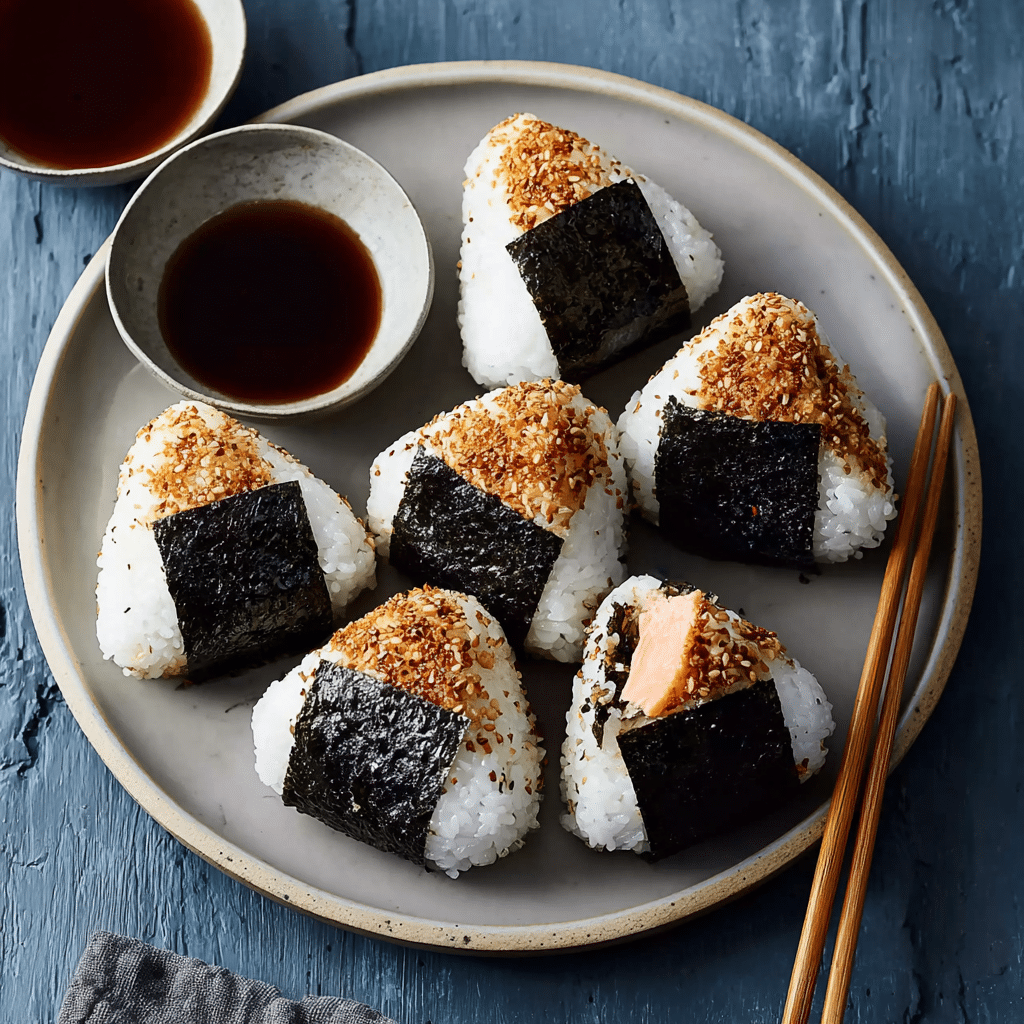The humble onigiri is a cherished staple of Japanese cuisine, beloved for its simplicity, portability, and versatility. With just a few basic ingredients—fluffy rice, savory salmon, and crisp nori—you can craft a nourishing snack or light meal that travels well and satisfies instantly.
This Salmon Onigiri recipe puts a delicious twist on tradition, pairing the buttery richness of cooked salmon with a subtle touch of soy sauce and sesame oil for depth. Wrapped in nori for added flavor and crunch, these rice balls are perfect for bento boxes, picnics, or even quick weeknight dinners. Whether you’re new to Japanese cooking or a longtime fan, this easy recipe is one you’ll return to again and again.
Full Recipe
Ingredients:
-
2 cups Japanese short-grain rice
-
2 ½ cups water
-
1 tbsp rice vinegar (optional)
-
1 tsp salt
-
1 cooked salmon fillet (approx. 150g), flaked
-
1 tbsp soy sauce
-
1 tsp sesame oil
-
1 tsp toasted sesame seeds
-
Nori sheets, cut into strips
-
Optional: Furikake, pickled plum (umeboshi), or avocado slices for extra filling
Directions:
-
Rinse the rice under cold water until the water runs clear. Drain well.
-
Combine the rice and water in a rice cooker or pot. Cook according to rice cooker instructions or bring to a boil, cover, reduce heat, and simmer for 18-20 minutes until tender. Let it rest covered for 10 minutes.
-
In a bowl, mix the flaked salmon with soy sauce, sesame oil, and sesame seeds. Set aside.
-
While rice is still warm, season with salt and rice vinegar (if using).
-
Wet your hands with water to prevent sticking. Take a handful of rice, flatten slightly in your palm, add 1 tsp of salmon filling, then shape into a triangle, gently pressing the edges to seal.
-
Wrap the bottom with a strip of nori for grip and added flavor.
-
Repeat until all rice and filling are used. Serve warm or at room temperature.
Prep Time: 15 minutes | Cooking Time: 20 minutes | Total Time: 35 minutes
Kcal: 180 kcal per onigiri | Servings: 6 onigiri
The Cultural Significance of Onigiri
Onigiri, or Japanese rice balls, have a long and rich history in Japanese cuisine, dating back to the Heian Period (794-1185). Initially used as a portable meal for travelers and warriors, onigiri became a staple thanks to its convenience and versatility. Unlike sushi, which is often associated with raw fish and seasoned rice, onigiri uses plain or lightly salted rice and is usually filled with savory ingredients like pickled plum (umeboshi), tuna, or grilled fish such as salmon. These rice balls are usually molded into triangular or cylindrical shapes and wrapped in a sheet of nori (dried seaweed) for easy handling and added flavor.
In modern Japan, onigiri remains a beloved comfort food. It’s found everywhere—from convenience stores and school lunchboxes (bento) to train stations and home kitchens. Making onigiri at home is a rite of passage for many Japanese children and is often associated with warmth, care, and family. Its simplicity is part of its charm, but there’s also room for endless creativity. Salmon onigiri is especially popular due to the natural umami flavor of the fish, and its compatibility with fluffy, slightly sticky short-grain rice.
Why Salmon Onigiri Is So Popular
Salmon onigiri, known as sake onigiri in Japan, is one of the most iconic and beloved variations of this dish. Salmon’s slightly smoky, salty profile pairs beautifully with plain white rice, creating a satisfying and protein-rich bite that is both hearty and flavorful. The filling typically uses grilled or broiled salmon, flaked into small pieces, and sometimes mixed with soy sauce, sesame oil, or furikake (a savory Japanese seasoning blend).
This makes salmon onigiri not only delicious but also highly nutritious. It’s rich in omega-3 fatty acids, high-quality protein, and beneficial minerals. Because of its simplicity and nutrient density, it’s perfect for meal prep, school lunches, or as a healthy on-the-go snack. It also travels well, especially when wrapped in nori just before eating, keeping the seaweed crisp and preventing sogginess.
Versatility and Customization Options
One of the greatest advantages of salmon onigiri is its adaptability. While the basic version uses cooked salmon and rice, there are countless ways to personalize the filling and presentation. Some popular additions include:
-
Avocado slices for creaminess
-
Mayonnaise (especially spicy mayo) for richness
-
Furikake to add crunch and seasoning
-
Umeboshi for a tart counterbalance
-
Pickled vegetables to introduce acidity
The rice itself can also be seasoned with a dash of rice vinegar or mixed with sesame seeds or chopped herbs like shiso. For a fun twist, some people pan-fry the formed onigiri to create yaki onigiri, which has a crispy exterior and adds a wonderful contrast in texture.
Additionally, you can shape onigiri in different forms—triangular is the most traditional, but round or cylindrical shapes are also common. For kids or themed events, onigiri can be molded into animal faces or other fun designs using molds and nori cutters.
Perfect for Bento Boxes and Meal Prep
Salmon onigiri shines as part of a well-balanced bento box. Pair it with items like tamagoyaki (Japanese rolled omelet), pickled radish, steamed vegetables, or edamame for a complete and visually appealing meal. Thanks to its portability, onigiri is ideal for lunchboxes, hikes, road trips, or picnics.
To make them ahead of time, wrap the onigiri tightly in plastic wrap and refrigerate. When ready to eat, allow them to come to room temperature for the best flavor and texture. It’s best to store the nori separately and wrap it around the rice just before eating to maintain its crispness.
For freezing, wrap each onigiri in plastic wrap and store in a freezer-safe bag. Reheat in the microwave until warm, then add the nori. This makes salmon onigiri an excellent option for batch cooking and keeping healthy snacks or meals on hand.
Nutrition and Health Benefits
Salmon onigiri is not just a treat for the tastebuds—it’s also a nutrient-rich meal. The salmon provides high-quality protein, heart-healthy fats (especially omega-3s), and vital nutrients such as B vitamins, selenium, and potassium. When paired with fiber-rich short-grain rice and nori, you get a balanced mix of macronutrients and minerals.
Short-grain rice is also a good source of carbohydrates, which are important for energy, especially for active individuals or children. If you’re looking to boost the fiber content, you can mix in some brown rice or even quinoa, though this may slightly alter the traditional texture.
This makes salmon onigiri an excellent choice for those following a gluten-free diet, as all components are naturally gluten-free (be sure to use gluten-free soy sauce if necessary). It’s a wholesome, satisfying, and accessible meal for nearly every dietary preference.
Tips for Perfect Onigiri Every Time
-
Use Japanese short-grain or sushi rice for the proper sticky consistency. Long-grain rice won’t hold together well.
-
Don’t overstuff your rice balls. Too much filling can cause them to fall apart. A teaspoon of salmon is usually sufficient per onigiri.
-
Wet your hands with water and salt before forming the rice. This prevents sticking and adds flavor.
-
Press gently but firmly when shaping. You want to compact the rice just enough so it holds its shape without becoming hard.
-
Wrap the nori last if not eating immediately. This keeps it from becoming soggy.
Cultural Notes and Modern Appeal
Salmon onigiri embodies the heart of Japanese food culture—simple ingredients, prepared with care, and enjoyed with gratitude. It’s a dish that transcends trends and remains relevant in today’s fast-paced world because of its ease, taste, and practicality.
In recent years, onigiri has grown in global popularity. It’s now common to see it in Asian fusion cafes, high-end bento shops, and even Western supermarkets. Social media has also played a role in its appeal, with creative onigiri designs and bento layouts captivating food lovers around the world.
Whether you’re a busy parent, a student, or someone looking to explore Japanese cuisine, salmon onigiri offers an approachable, flavorful, and deeply satisfying experience. It’s also a fantastic recipe to make with children, introducing them to new textures, ingredients, and cultures in a hands-on, enjoyable way.
Conclusion
Salmon onigiri is more than just a rice ball—it’s a delicious representation of Japanese tradition, convenience, and balance. Combining nutrient-rich salmon with fragrant rice and savory nori, it makes for a wholesome meal or snack that satisfies on every level. Whether enjoyed fresh, packed in a lunchbox, or pulled from the freezer for a quick bite, this dish offers comfort, nutrition, and a taste of Japan in every bite.
With its simplicity, adaptability, and global appeal, salmon onigiri is a must-try for anyone who loves cooking, healthy eating, or exploring international flavors. It’s not just a recipe—it’s an invitation to slow down, enjoy the process, and nourish both body and soul with something truly meaningful.






